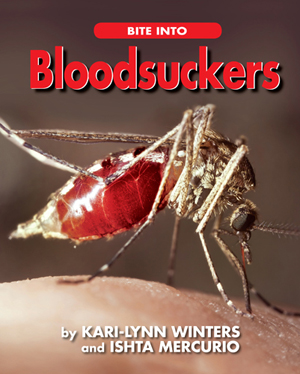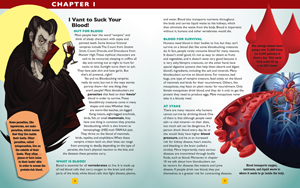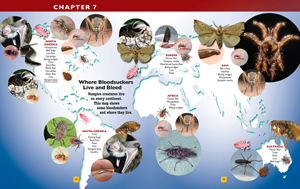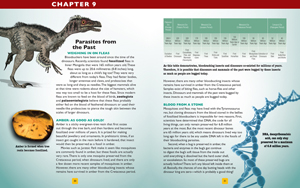| ________________
CM . . .
. Volume XXII Number 5. . . .October 2, 2015 
 |
Bite Into Bloodsuckers. (Up Close with Animals).
Kari-Lynn Winters & Ishta Mercurio.
Markham, ON: Fitzhenry & Whiteside, 2015.
48 pp., hardcover, $19.95.
ISBN 978-1-55455-326-6.
Subject Heading:
Bloodsucking animals-Juvenile literature.
Grades 4-6 / Ages 9-11.
Review by Gail Hamilton.
***½ /4
|
| |
|

excerpt:
Adult horseflies, sometimes called zimbs or clegs, are large flies that typically survive on nectar and pollen. However, in order to reproduce, female horseflies need protein. Where do they find this protein? In blood, of course!
These vampires slash through their hosts’ fur and skin using sharp, blade-like mouthparts. Then they lap the flowing blood with a sponge-like organ called a labella. Female horseflies can lap blood in this way for up to six hours.
Farmers use fly traps and sprays to rid their fields and stables of horseflies. This is because female horseflies, when on the hunt for blood, become a nuisance to livestock and ultimately to the farmers themselves. They have been known to swarm cattle to such an extent that the cattle feel threatened and produce less milk. Also, these irritating pests are sometimes the cause of injuries, both from the bite wounds themselves and from the accidents caused when cattle or horses try to escape.
 It is estimated that there are over 500 trillion bloodsucking animals living on Earth. These “vampires”, despite their bad reputations, play a vital role in Earth’s ecosystem, and many of them actually help humans. Most bloodsuckers are parasites that need their hosts’ blood in order to survive. Their bites can be benign, merely annoying, or deadly, depending on the type of parasite and the disease it might be carrying. Victims- mammals, birds, amphibians and reptiles (and even some insects)- react to the bites in different ways, and even animals of the same species can react in a variety of ways. For example, about 20-25% of humans are not bothered at all by bed bug bites; the others display itchy, red bumps where they have been bitten. It is estimated that there are over 500 trillion bloodsucking animals living on Earth. These “vampires”, despite their bad reputations, play a vital role in Earth’s ecosystem, and many of them actually help humans. Most bloodsuckers are parasites that need their hosts’ blood in order to survive. Their bites can be benign, merely annoying, or deadly, depending on the type of parasite and the disease it might be carrying. Victims- mammals, birds, amphibians and reptiles (and even some insects)- react to the bites in different ways, and even animals of the same species can react in a variety of ways. For example, about 20-25% of humans are not bothered at all by bed bug bites; the others display itchy, red bumps where they have been bitten.
 Bite into Bloodsuckers, part of the “Up Close with Animals” series, is divided into 13 chapters, each of which has catchy- and often humourous- headings and subheadings that entice readers. What reader could resist a section entitled “Sharing in the Blood Bath”, “Sensing a Blood Buffet” or “What Makes a Tick Tick?” Bloodsuckers can be fliers, crawlers or swimmers, and in this book readers will not only learn about many that might already be familiar to them, such as leeches and deer flies, but they will also find out about lesser known bloodsuckers, such as vampire finches, kissing bugs, torpedo snails and lampreys. Bite into Bloodsuckers, part of the “Up Close with Animals” series, is divided into 13 chapters, each of which has catchy- and often humourous- headings and subheadings that entice readers. What reader could resist a section entitled “Sharing in the Blood Bath”, “Sensing a Blood Buffet” or “What Makes a Tick Tick?” Bloodsuckers can be fliers, crawlers or swimmers, and in this book readers will not only learn about many that might already be familiar to them, such as leeches and deer flies, but they will also find out about lesser known bloodsuckers, such as vampire finches, kissing bugs, torpedo snails and lampreys.
 Topics in this book include what attracts a bloodsucker to its host, how the bloodsucker feeds, the effect of its bite, and what humans can do to prevent bloodsuckers from biting them. Helpful hints provide ideas for keeping bloodsuckers at bay both inside and outside the house, and there is even a recipe for a homemade, natural bug repellent and do’s and don’ts for safely removing a tick. One section focuses on the various diseases caused by bloodsucking creatures: typhus, Bubonic plague, Lyme disease, Rocky Mountain spotted fever, malaria, encephalitis and West Nile virus, while another highlights the positive uses of “vampires”: using leeches in the field of medicine, kissing bugs to extract blood from zoo animals (thereby eliminating the need for tranquilization of larger or dangerous animals), and mini flea robots whose design was inspired by fleas. These mini robots can detect radiation, land minds and explosives. In addition, Bite into Bloodsuckers features a map of the world, indicating where various bloodsucking animals are found, a section about past parasites from prehistoric times, some examples of life cycles (complete metamorphosis of a mosquito and incomplete metamorphosis of a kissing bug), and a metamorphosis game. Throughout the text are interesting facts and statistics. One surprising fact is that, if all of the mosquitoes alive today were weighed, and all of the humans living today were weighed, the weights would be the about the same. Topics in this book include what attracts a bloodsucker to its host, how the bloodsucker feeds, the effect of its bite, and what humans can do to prevent bloodsuckers from biting them. Helpful hints provide ideas for keeping bloodsuckers at bay both inside and outside the house, and there is even a recipe for a homemade, natural bug repellent and do’s and don’ts for safely removing a tick. One section focuses on the various diseases caused by bloodsucking creatures: typhus, Bubonic plague, Lyme disease, Rocky Mountain spotted fever, malaria, encephalitis and West Nile virus, while another highlights the positive uses of “vampires”: using leeches in the field of medicine, kissing bugs to extract blood from zoo animals (thereby eliminating the need for tranquilization of larger or dangerous animals), and mini flea robots whose design was inspired by fleas. These mini robots can detect radiation, land minds and explosives. In addition, Bite into Bloodsuckers features a map of the world, indicating where various bloodsucking animals are found, a section about past parasites from prehistoric times, some examples of life cycles (complete metamorphosis of a mosquito and incomplete metamorphosis of a kissing bug), and a metamorphosis game. Throughout the text are interesting facts and statistics. One surprising fact is that, if all of the mosquitoes alive today were weighed, and all of the humans living today were weighed, the weights would be the about the same.
Illustrations include wonderful colour photographs and a few charts and maps. The fluent text and attractive layout, combined with the great photos, make Bite into Bloodsuckers a very appealing read that is most worthy of purchase.
Highly Recommended.
Gail Hamilton is a former teacher-librarian in Winnipeg, MB.

To comment
on this title or this review, send mail to cm@umanitoba.ca.
Copyright © the Manitoba Library Association. Reproduction for personal
use is permitted only if this copyright notice is maintained. Any
other reproduction is prohibited without permission.
Next Review |
Table of Contents for This Issue
- October 2, 2015.
CM Home | Back Issues
| Search
| CM Archive
| Profiles Archive
|

 It is estimated that there are over 500 trillion bloodsucking animals living on Earth. These “vampires”, despite their bad reputations, play a vital role in Earth’s ecosystem, and many of them actually help humans. Most bloodsuckers are parasites that need their hosts’ blood in order to survive. Their bites can be benign, merely annoying, or deadly, depending on the type of parasite and the disease it might be carrying. Victims- mammals, birds, amphibians and reptiles (and even some insects)- react to the bites in different ways, and even animals of the same species can react in a variety of ways. For example, about 20-25% of humans are not bothered at all by bed bug bites; the others display itchy, red bumps where they have been bitten.
It is estimated that there are over 500 trillion bloodsucking animals living on Earth. These “vampires”, despite their bad reputations, play a vital role in Earth’s ecosystem, and many of them actually help humans. Most bloodsuckers are parasites that need their hosts’ blood in order to survive. Their bites can be benign, merely annoying, or deadly, depending on the type of parasite and the disease it might be carrying. Victims- mammals, birds, amphibians and reptiles (and even some insects)- react to the bites in different ways, and even animals of the same species can react in a variety of ways. For example, about 20-25% of humans are not bothered at all by bed bug bites; the others display itchy, red bumps where they have been bitten. Bite into Bloodsuckers, part of the “Up Close with Animals” series, is divided into 13 chapters, each of which has catchy- and often humourous- headings and subheadings that entice readers. What reader could resist a section entitled “Sharing in the Blood Bath”, “Sensing a Blood Buffet” or “What Makes a Tick Tick?” Bloodsuckers can be fliers, crawlers or swimmers, and in this book readers will not only learn about many that might already be familiar to them, such as leeches and deer flies, but they will also find out about lesser known bloodsuckers, such as vampire finches, kissing bugs, torpedo snails and lampreys.
Bite into Bloodsuckers, part of the “Up Close with Animals” series, is divided into 13 chapters, each of which has catchy- and often humourous- headings and subheadings that entice readers. What reader could resist a section entitled “Sharing in the Blood Bath”, “Sensing a Blood Buffet” or “What Makes a Tick Tick?” Bloodsuckers can be fliers, crawlers or swimmers, and in this book readers will not only learn about many that might already be familiar to them, such as leeches and deer flies, but they will also find out about lesser known bloodsuckers, such as vampire finches, kissing bugs, torpedo snails and lampreys. Topics in this book include what attracts a bloodsucker to its host, how the bloodsucker feeds, the effect of its bite, and what humans can do to prevent bloodsuckers from biting them. Helpful hints provide ideas for keeping bloodsuckers at bay both inside and outside the house, and there is even a recipe for a homemade, natural bug repellent and do’s and don’ts for safely removing a tick. One section focuses on the various diseases caused by bloodsucking creatures: typhus, Bubonic plague, Lyme disease, Rocky Mountain spotted fever, malaria, encephalitis and West Nile virus, while another highlights the positive uses of “vampires”: using leeches in the field of medicine, kissing bugs to extract blood from zoo animals (thereby eliminating the need for tranquilization of larger or dangerous animals), and mini flea robots whose design was inspired by fleas. These mini robots can detect radiation, land minds and explosives. In addition, Bite into Bloodsuckers features a map of the world, indicating where various bloodsucking animals are found, a section about past parasites from prehistoric times, some examples of life cycles (complete metamorphosis of a mosquito and incomplete metamorphosis of a kissing bug), and a metamorphosis game. Throughout the text are interesting facts and statistics. One surprising fact is that, if all of the mosquitoes alive today were weighed, and all of the humans living today were weighed, the weights would be the about the same.
Topics in this book include what attracts a bloodsucker to its host, how the bloodsucker feeds, the effect of its bite, and what humans can do to prevent bloodsuckers from biting them. Helpful hints provide ideas for keeping bloodsuckers at bay both inside and outside the house, and there is even a recipe for a homemade, natural bug repellent and do’s and don’ts for safely removing a tick. One section focuses on the various diseases caused by bloodsucking creatures: typhus, Bubonic plague, Lyme disease, Rocky Mountain spotted fever, malaria, encephalitis and West Nile virus, while another highlights the positive uses of “vampires”: using leeches in the field of medicine, kissing bugs to extract blood from zoo animals (thereby eliminating the need for tranquilization of larger or dangerous animals), and mini flea robots whose design was inspired by fleas. These mini robots can detect radiation, land minds and explosives. In addition, Bite into Bloodsuckers features a map of the world, indicating where various bloodsucking animals are found, a section about past parasites from prehistoric times, some examples of life cycles (complete metamorphosis of a mosquito and incomplete metamorphosis of a kissing bug), and a metamorphosis game. Throughout the text are interesting facts and statistics. One surprising fact is that, if all of the mosquitoes alive today were weighed, and all of the humans living today were weighed, the weights would be the about the same.